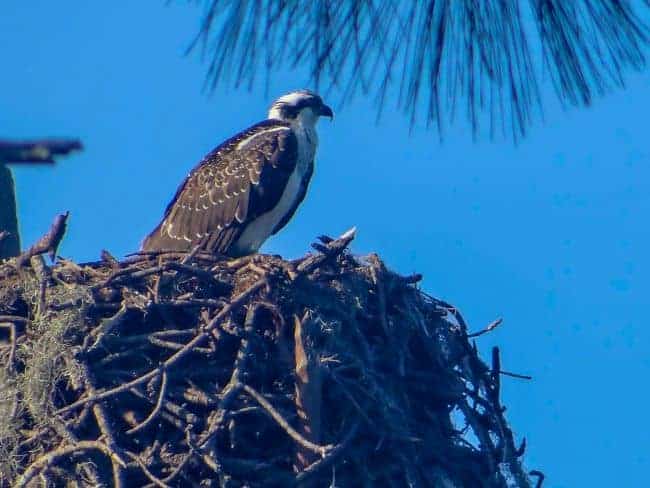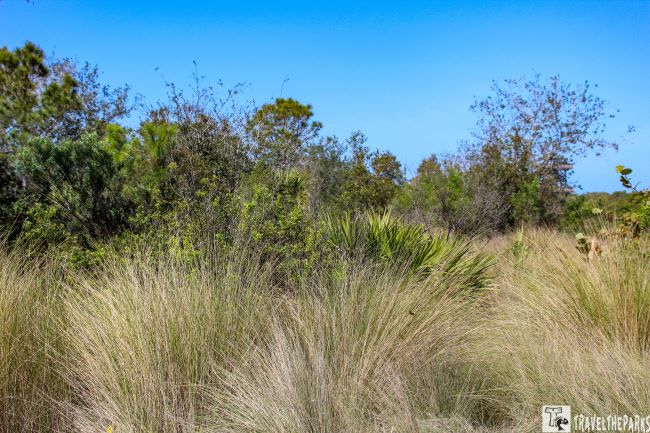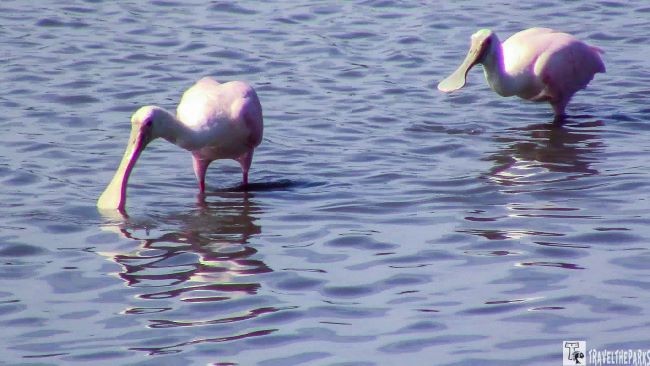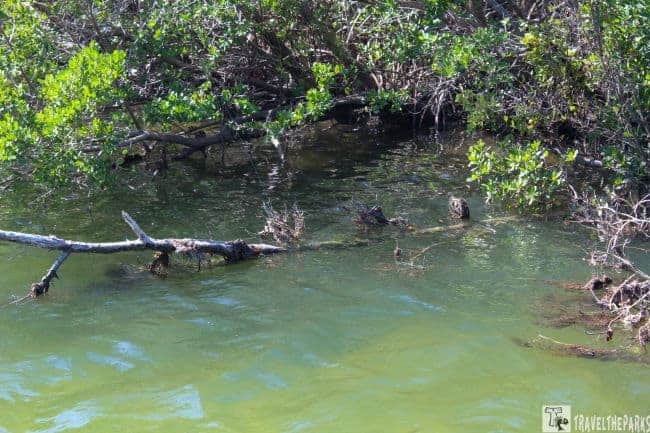For those seeking tremendous hiking in Robinson Preserve, there are over 10 miles of excellent hiking trails winding through it, with opportunities to explore this natural environment. A serene, peaceful walk, I can’t believe the hustle and bustle of Bradenton and the beaches of Anna Maria Island surrounded this preserve.
The preserve covers an area of over 480 acres. This park offers visitors a variety of recreational activities, including hiking, kayaking, canoeing, birdwatching and fishing. The preserve features a variety of habitats, including saltwater marshes, mangrove swamps, and tidal flats. It is home to a wide range of wildlife, including fish, birds, and mammals.

This post may contain affiliate links, meaning if you purchase something through one of these links, we may earn a small commission at no extra cost to you! Read the full disclosure policy here.

Table of Contents
Where is Robinson Preserve?
The preserve has multiple access points for visitors, and the best way to get there will depend on where you are coming from. It is an easy day trip from anywhere in Central Florida.
From Orlando, I-4 west to I-75 south, take Manatee Avenue West (SR 64) to the intersection of 75th Street West. Turn left onto 75th Street and continue north for approximately 2.5 miles. The entrance will be on your right.

From Anna Maria Island, take Gulf Drive north to Manatee Avenue (SR 64). Turn right onto Manatee Avenue and continue east for approximately 3 miles. Turn right onto 9th Avenue and continue south for approximately 1 mile. The entrance will be on your left.

If you are coming from Everglades/Sarasota or points south, take US-41 north to SR 684 (Cortez Road). Turn left onto Cortez Road and continue west for approximately 5 miles. Turn right onto 119th Street West and continue north for approximately 2.5 miles. The entrance will be on your left.
Once you arrive at Robinson Preserve, there are parking lots available for visitors open daily from dawn until dusk. Robinson Preserve is open to the public throughout the year, and there is no entrance fee.

History of Robinson Preserve
They originally used the land that now makes up Robinson Preserve for farming and ranching. In the early 20th century, the Robinson family, who used it for cattle grazing and as a hunting ground, purchased it. In the 1980s, the family considered developing the land for housing, but eventually preserved it as a natural area.

In 2002, Manatee County purchased the land from the Robinson family with the help of funding from the Florida Communities Trust and the Southwest Florida Water Management District. The county then developed the area as a nature preserve. This expanse of waterfront habitats has undergone extensive restoration, from removal of invasive species to re-creating tidal creeks and basins nourished by the rise and fall of Tampa Bay.

Over the years, Robinson Preserve has become a popular destination for outdoor recreation, attracting visitors from all over the region. In addition to its recreational opportunities, the preserve is also an important habitat for a variety of plants and animals, including manatees, dolphins, and a wide variety of birds. The Manatee County Parks and Natural Resources Department, which works to balance public use with the preservation of the natural environment, manages the preserve.

Hiking Robinson Preserve trail guide
It thrilled us that this park offers over 10 miles of hiking trails. What a great destination for nature enthusiasts and hikers. The pathways are very well-maintained. We found the trails here are convenient for hikers on all levels, with options for both easy and more challenging hikes. I recommend wearing comfortable shoes, sunscreen, bug spray, a hat, sunglasses and plenty of water. The best times to visit this trail are October through May.
There are plenty of boardwalks and places to walk along the water amongst the sea grapes. Peek-a-boo spots with sandy beaches hidden amongst the mangrove nooks and crannies. There is a plethora of places to find your special spot and appreciate the peace and quiet. On any given day, you may come upon egrets, eagles, osprey, hawks, herons, terns, brown or white pelicans, ibis, cormorants, wood storks, roseate spoonbills, and various other wading birds. Good photo opportunities abound.

Tower Trail: Nature walks in Robinson Preserve, Florida
I must say we enjoyed the 0.5 mile tower trail. Starting from the parking lot, we turned right at the first trail intersection. The wide hard-packed shell pathway traverses through a cordgrass coastal salt marsh. These freshwater grasses have an incredible tolerance for salt. The trail winds through and you can see the tower looming in the distance. A left turn takes you directly to a curved wooden boardwalk over the waterway to the foot of the observation tower.

Climb to the top of the Observation Tower
To reach the 53-foot tall tower near the western edge of the preserve, park at the north entrance parking lot and follow the signs. The tower is accessible via a boardwalk that winds through the wetlands and ends at the base of the tower. Climbing the wooden stairs up the 6 stories leads to breathtaking 360°, panoramic views of the entire preserve and the surrounding estuary. We were in awe of the endless vistas, including the Manatee River, Anna Maria Island, and the Sunshine Skyway Bridge.

From the top of the tower, we could see a variety of wading birds, fish, dolphins, and manatees. Check out the corners of the building top. The wood carvings are a nice touch. After descending the tower, if you take the left trail, you can complete the Osprey loop by crossing over the wooden bridge and following the shell bed path. Otherwise, retrace your steps to the parking lot.

The observation tower is open to visitors during regular preserve hours, from dawn until dusk. It is free to access and is a great spot to take in the natural beauty of this area and appreciate the diverse ecosystem that makes up Robinson Preserve. On our last trip we walked the 4 miles, taking approximately 2 hours. It was part of our day trip to De Soto National Memorial. Today, from the elevated boardwalk, we also spotted an array of fish. You can find needlefish, snook, sheepshead, mullet, and a few crustaceans. Wading birds were everywhere.
NOTE: Dogs are welcome, but must be on a leash. Go early and when the weather is cooler as most trails offer little shade.

Robinson Preserve nature trails: Spoonbill Trail & Osprey Loop
The most popular paved trail is the Spoonbill. They named it after the Roseate Spoonbill, a beautiful pink wading bird we spotted throughout the preserve’s wetlands. We combined it with the Osprey loop, making it a longer loop trail that takes hikers and cyclists through the best of the preserve. It is approximately 5.7 miles long. The trail winds through the preserve’s various habitats.

Most impressive are the lush mangrove tunnels, and the exposed bay breaks in the sea grape and buttonwood bushes leading to pristine sand beaches. Two different osprey platforms are along this trail. In the winter months, both hold chicks and can easily be photographed without disturbing them. Click for trail map. The preserve has plenty benches along the trail, giving you a chance to sit and reflect or just take in the views.

Consider these Favorite Trails at Robinson Preserve
Some of our other favorite hiking trails in Robinson Preserve include:
- Eagle Trail: This is a 2.5-mile loop trail that is for walkers only through the heart of the preserve. It offers scenic views of the wetlands, mangrove forests, and bridges that interconnected marsh islands.
- Tern Trail: This is a 1.4-mile out & back trail that takes you along the northern edge of the preserve to Mead Point. The primitive trail offers views of the mangrove and is a great spot to escape and reflect.
- Osprey Loop: This is a 3.1-mile loop trail that took us to a long wooden boardwalk overlooking the mangrove forest before continuing along the Tampa Bay. I especially loved that it offers scenic views of the preserve’s wetlands and is a great spot for birdwatching. There isn’t a lot of shade on this trail.
- Perico Boardwalk: This is a 0.3-mile boardwalk trail that takes you through the preserve’s mangrove forests. It offers a chance to commune with nature while enjoying scenic views overlooking the water. It is a great spot for spotting wildlife.
- The new Nest at Robinson Preserve is a 0.3-mile loop trail. Elevated walkway features an extensive educational experience. The Mosaic Nest and Canopy have a playground area for the kids.

Nature walks in Robinson Preserve: Try Completing all the Trails
If you decide to do the entire trail system, it creates a 7.5-mile loop. The combination of crisscrossing paved asphalt, wooden boardwalks and crushed shell pack will take approximately 3-4 hours. This is also a popular biking spot. It would be an ideal morning ride. The park rules and regulations require you yielding to hikers and other trail users. We encountered lots of bikers. On one visit, we had a near miss. It is advisable to stay visible on the blind curves of the trail.

Kayaking Trails
There are also several waterways that run through the preserve, including the 2.5-mile long Robinson Preserve Paddling Trail. This trail gives visitors the opportunity to explore the mangrove tunnels and coastal wetlands of the park by kayak, canoe or paddleboard. These intertidal habitats (salt marshes and mangroves), help protect the vital shoreline from erosion. The preserve offers online kayak & paddleboard rentals through surferbus.com (941-527-6355).

The preserve also has several fishing piers and a canoe/kayak launch for those with their own equipment. The park permits fishing only in designated areas and during certain hours. It is important to remember a fishing license is required for individuals over the age of 16. Specific fishing regulations need to be followed. On most days, you can watch mullet feeding and chasing bait from the boardwalks. Most anglers seemed to be catching catfish the day we visited. In season Snook can be found in the inland canals., Today we found a rather large snook just under one of the bridges hidden in the mangroves.

Moving History the Acquisition of Valentine House
The Valentine family originally built the family house in 1918. The clan were early settlers in the area. The home is a two-story wooden structure with a wrap-around porch and gabled roof. They constructed it using local materials using traditional Florida Cracker-style architecture. The house remained in the Valentine family until the early 2000s, when they sold it to Manatee County as part of the creation of Robinson Preserve.

After the county gained the Valentine House, it underwent a major restoration project to bring it back to its original condition. The restoration work included repairing and replacing the building’s foundation, roof, and siding, as well as restoring the interior finishes, such as the original wood floors and trim.

Today, the Valentine House serves as a visitor center and event space for Robinson Preserve. It is open to the public for tours, and can also be rented for weddings, parties, and other events. The building provides a unique and historic backdrop for events, and its location in the north section of the preserve allows visitors to enjoy the natural environment while also being educated about its history.

Final Thoughts on Tremendous Hiking in Robinson Preserve
Overall, the many trails within Robinson Preserve offer a great opportunity to experience Florida’s natural beauty and to experience quiet tranquility. The park gave us ample access for birdwatching, photography, or just enjoying a beautiful day outside. If you like outdoor experiences, this is some of the best Manatee County offers.
Have you hiked in Robinson Preserve? Which hike did you like best? Drop us a comment below. We would love to hear from you!




